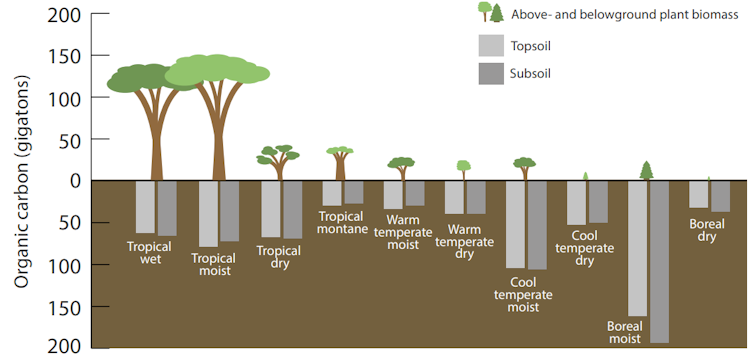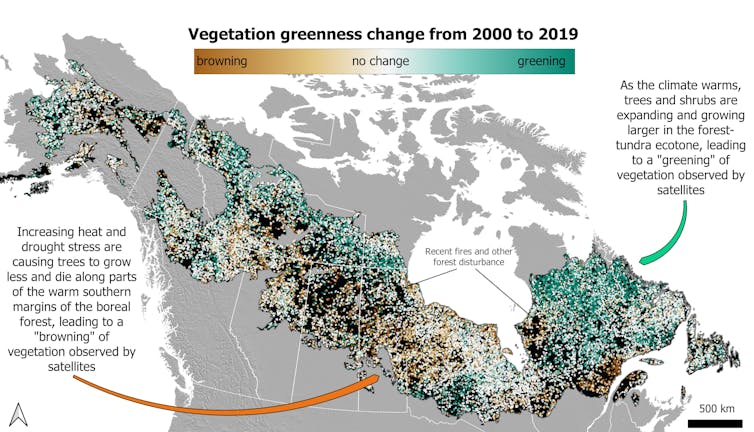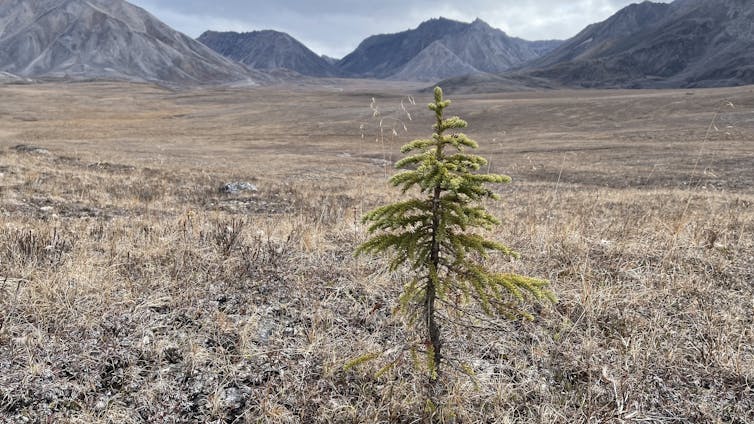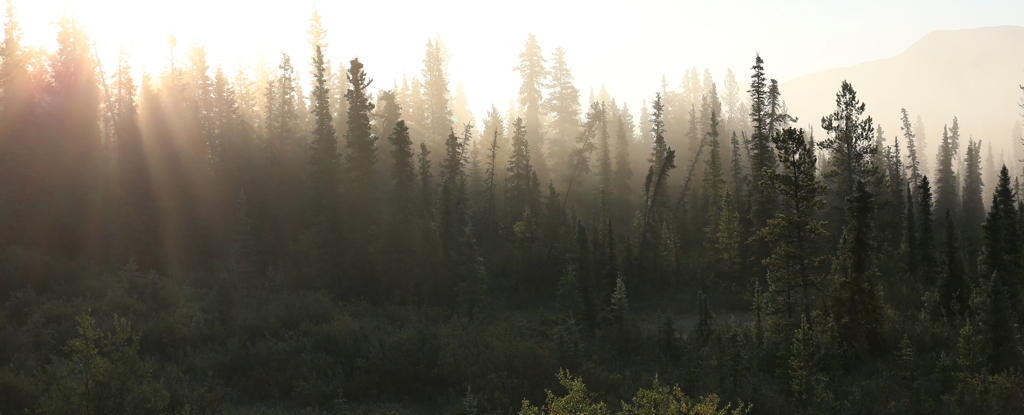Products You May Like
Earth’s boreal forests circle our planet’s far northern reaches, just south of the Arctic’s treeless tundra. If the planet wears an Arctic ice cap, then the boreal forests are a loose-knit headband wrapped around its ears, covering large portions of Alaska, Canada, Scandinavia and Siberia.
The boreal region’s soils have long buffered the planet against warming by storing huge quantities of carbon and keeping it out of the atmosphere. Its remoteness has historically protected its forests and wetlands from extensive human impact.
These two traits rank boreal forests among the most important ecosystems on Earth. In addition, numerous species of mammals, fish, plants, insects and birds make these forests home.
For over two centuries, scientists have recognized that climate plays a key role in determining the geographic zones of plant communities. Because boreal forests and soils face subzero winters and short summers, these forests and the animals that live in them are shifting northward as temperatures rise.
However, boreal forests’ northward advance has been spotty and slower than expected. Meanwhile, their southern retreat has been faster than scientists predicted. As scholars who study northern ecosystems, forests and wetlands, we see concerning evidence that as the world warms, its largest forest wilderness appears to be shrinking.
The largest wilderness on Earth
Boreal forests contain billions of trees. Most are needleleaf, cone-bearing conifers, but there also are patches of broadleaf species, including birch, aspen and poplar. They support millions of migratory birds and iconic mammals like brown bears, moose and lynx.
These trees and the soils around their roots help regulate Earth’s climate, in part by pulling carbon dioxide out of the atmosphere, where it would otherwise act as a greenhouse gas. The trees use this carbon to grow roots, trunks and leaves, which eventually turn into carbon-rich soil once the tree dies. Significant changes to the forests will translate to changes in global climate.
These forests are warming at rates well above the global average. Rising temperatures directly affect the growth and survival of trees and, in turn, their ability to store carbon.

Forests on the move
As atmospheric warming frees trees from the icy grip of cold temperatures, adult trees can respond by growing faster. Milder temperatures also allow young seedling trees in the most northern boreal forests to gain a foothold where previous conditions were too harsh for them to become established.
In the warmer, southern boreal forests, the situation is quite different. Here, conditions have become too warm for cold-adapted boreal trees, slowing their growth and even leading to their death. With warming comes dryness, and water stress leaves trees more susceptible to insect infestation and fires, as Canada has experienced in 2023 and Siberia in 2019 and 2020.
If this happens at a larger scale, southern boreal forest boundaries will thin and degrade, thereby retreating farther north, where temperatures are still suitable.
If boreal forests expand northward and retreat in the south at the same rates, they could slowly follow warming temperatures. However, our combined research using satellite and field data shows that the story is more complex.
Tracking forests from space
Satellites are invaluable for tracking how boreal forests have changed in recent decades and whether these changes are consistent with an overall northward shift. Researchers can use satellites to monitor year-to-year changes in forest characteristics, such as annual tree growth and tree cover.
Our recent studies using satellite data showed that tree growth and tree cover increased from 2000 to 2019 throughout much of the boreal forest. These changes occurred mainly in the coldest northern areas. However, there was limited evidence to indicate that forests were expanding past current tree lines.
Our studies also revealed that tree growth and tree cover often decreased from 2000 to 2019 in warmer southern areas of the boreal forests. In these regions, hotter and drier conditions frequently reduced tree growth or killed individual trees, while wildfires and logging contributed to tree cover loss.
Satellite data makes it clear that climate change is affecting both the northern and southern margins of the boreal forest. However, if tree cover loss in the south occurs more rapidly than gains in the north, then the boreal forest will likely contract, rather than simply shifting northward.

Zooming in to understand forest change
Forests advance when individual tree seeds germinate and grow, but boreal trees grow slowly and require decades to reach a size that’s visible from space. Finding young trees whose presence would signal tree-line movement requires data from the ground.
In the late 1970s, one of us (David Cooper) documented that young spruce trees were growing at altitudes hundreds of yards higher and locations miles north of the highest-elevation cone-bearing trees in Alaska’s Brooks Range. Returning in 2021, we found those little trees had grown to be several yards tall and were producing cones. More importantly, 10 times the number of young spruces now grow above and beyond the tree line than during our first field forays.
Crisscrossing the boundary between Alaska’s boreal forest and its Arctic tundra on foot, we have found thousands of young boreal trees growing up to 25 miles north of established tree lines. Most grow where deeper snows fall, due to an Arctic Ocean version of the “lake effect“: Cold air moves across open water, picking up warmth and moisture, which then falls as snow downwind.
Retreating sea ice leaves more open water. This generates stronger winds that propel tree seeds farther and more snowfall that insulates seedlings from harsh winter conditions. The result is that trees in Alaska’s Brooks Range are rapidly moving into the treeless tundra. However, these rapid expansions are localized and do not yet happen everywhere along the northern tree line.

The future face of boreal forests
Our combined research shows that boreal forests are, in fact, responding to rising temperatures. But rapid rates of climatic change mean that trees likely can’t move northward at a pace that keeps up with their loss in the south.
Will trees in the far north ever catch up with climate and prevent forest contraction? At this point, scientists simply don’t know. Perhaps the newly established trees in the Brooks Range herald such an expansion. It’s also unclear whether the northern parts of boreal forests can accumulate enough carbon through increased growth to compensate for carbon losses in the south.
If boreal forests are indeed on the verge of contracting, they will eventually disappear from their current southern edge. This would harm many native and migratory animals, especially birds, by reducing their boreal habitat. The forests also are culturally important to several million people who call them home, such as Canada’s aboriginal communities.
Monitoring boreal forests around the world more closely, using both satellite data and on-the-ground measurements, will help fill out this picture. Only then can researchers hope to glimpse the future of one of the Earth’s last wildernesses.![]()
Ronny Rotbarth, Ph.D. Candidate of Arctic and Sub-Arctic Ecology, Wageningen University; David J. Cooper, Senior Research Scientist Emeritus, Colorado State University; Logan Berner, Assistant Research Professor of Global Change Ecology, Northern Arizona University, and Roman Dial, Professor of Biology and Mathematics, Alaska Pacific University
This article is republished from The Conversation under a Creative Commons license. Read the original article.
